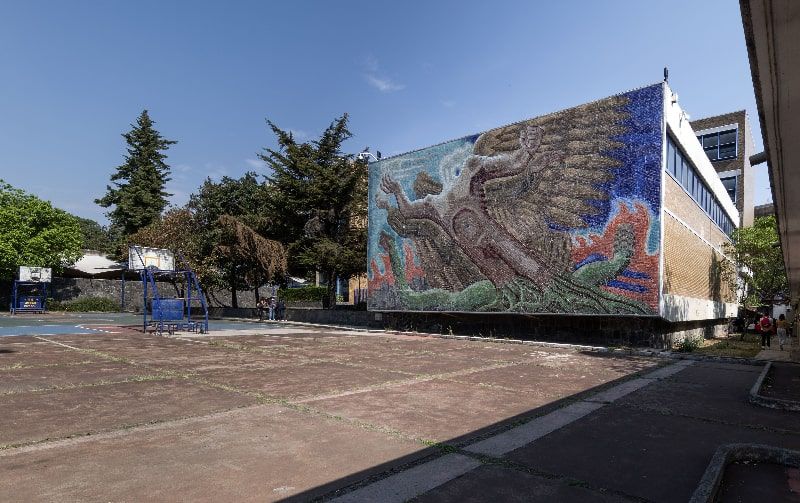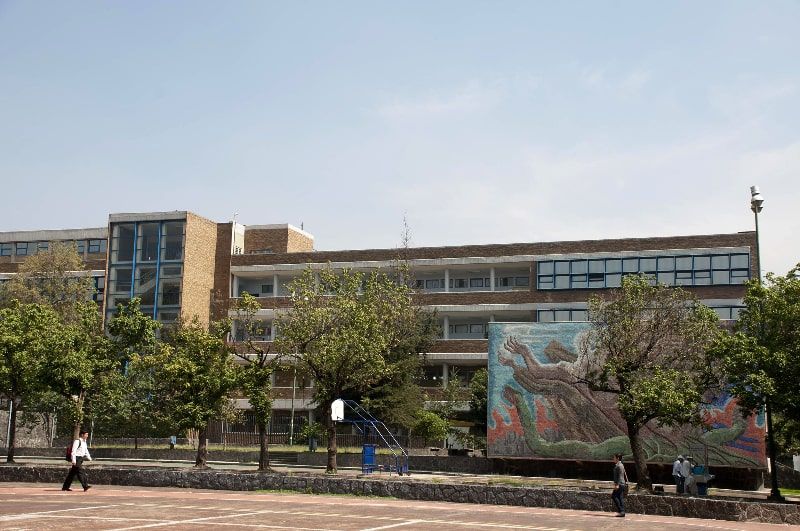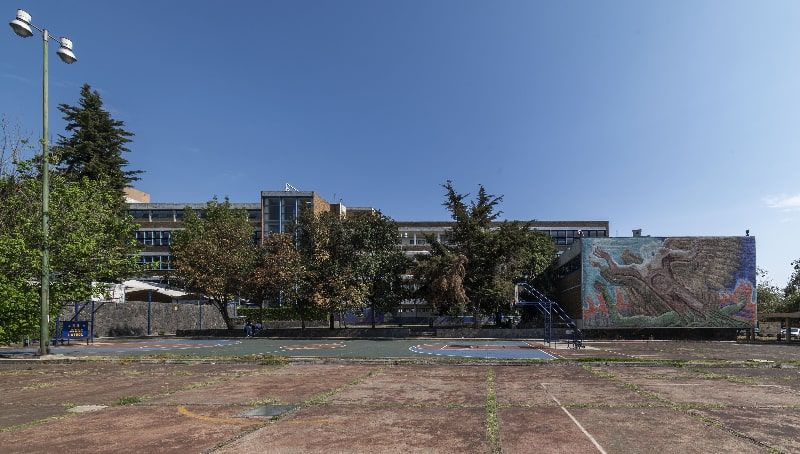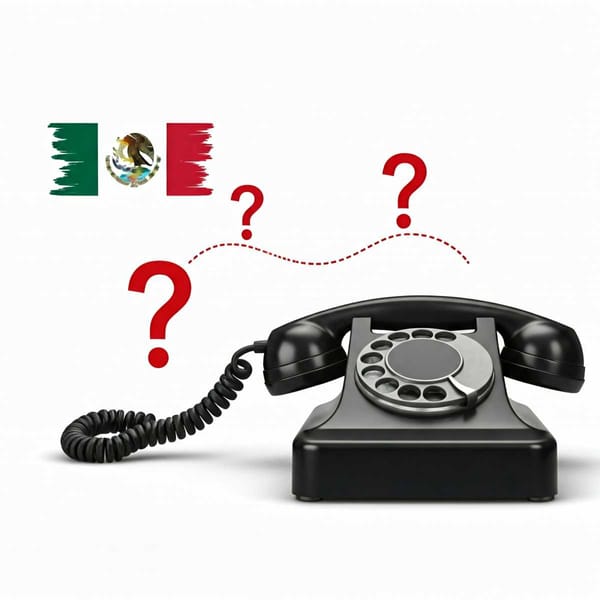Mural "The overcoming of man through culture" by Francisco Eppens Helguera
This work adorns the exterior wall of the José J. Rojo Auditorium at the School of Dentistry in the University City. Its designer, Francisco Eppens Helguera, was a seasoned muralist and experimented with sculpture, oil, and other plastic media.

In the Greek myth, Prometheus steals from the gods Hephaestus and Athena the wisdom of the arts and fire to give it to men, thus humanity obtained the necessary tools to perpetuate life.
This history of universal culture was the inspiration for the mural La superación del hombre por medio de la cultural ("The overcoming of man through culture"), designed by plastic artist Francisco Eppens Helguera, which has adorned the exterior wall of the José J. Rojo Auditorium of the School of Dentistry in Ciudad Universitaria (University City) since 1953.
The work is, for Mireida Velázquez Torres -director of the National Museum of San Carlos and former coordinator of the Program in Curatorial Studies in the Master's Program in Art History at UNAM- one of the highlights of Eppens' career, along with the other mural he designed for the School of Medicine.
"Francisco Eppens is a prolific artist who experimented with different plastic media; he is remembered in the history of Mexican art for his work as an illustrator, but he was also a seasoned muralist and experimented with sculpture, oil painting, and other plastic media. He did not stay in only one medium although his name is linked to illustration and the creation of drawings for use in postal and fiscal stamps since, from 1935 to 1951, he worked in the Talleres de Impresión de Estampillas y Valores de la Secretaría de Hacienda y Crédito Público (Stamp and Securities Printing Workshops of the Secretaría de Hacienda y Crédito Público)."
"There he was in charge of bringing to the drawing the fundamental programs of the Mexican government and presidential speeches, especially during the government of Lázaro Cárdenas. It is a very important work; many identify him through these pieces. However, the works that made him famous, that put him in the spotlight, are the murals he painted in Ciudad Universitaria, both in the School of Medicine and the School of Dentistry", explained Velázquez Torres.

Recurring theme
Mural "La superación del hombre por medio de la cultura" ("Man's Improvement through Culture") is an example of the recurring themes in Eppens' work, including his conviction that education and culture were necessary for human advancement, in addition to the benefits that the Mexican Revolution had brought to Mexican society. It was architect Carlos Lazo, then general manager of Ciudad Universitaria's Works during its construction, who invited Eppens to join the group of artists in charge of creating the murals.
The mural at the School of Dentistry makes a lot of sense in an educational institution. It explains one of the functions of such an important campus for Mexico as UNAM. In the end, that is the objective: to help men and women to better themselves through education and culture. This synthesis of objectives is somewhat what Francisco Eppens had in mind when he sketched his proposal for the mural. He takes up themes that are important to him, from his work as an illustrator he puts a lot of emphasis on education, on the right to it, and meaning as a way to transform society on a material and spiritual level.
"He was a fervent believer in this possibility that education means and what better than to put it into practice, to make it visible to all the students of this university campus, which reflects not only the artistic and cultural achievements of the country but also at an educational level. The architecture of the campus reflected this and the project had to be in line with the possibility of achieving the plastic integration proposed by the artists of that time, establishing a dialogue between the architecture and the environment in which the mural was proposed with the work itself. Eppens refers to national and universal history, he takes a theme of universal character to create his mural proposal."
"Eppens believed convincedly in the achievements of the Revolution, he saw what had been gained at the social level and, within them, education as one of the fundamental axes of the revolutionary transformation. It is a theme that he frequently addresses in his illustrations, we can see how the physical labor of the workers and the working class is fundamental for him; this link with a more nationalist iconography is materialized in the mural of the PRI headquarters and his design for the national coat of arms. He is an artist who works close to the State; he gives that visual translation to the slogans of the Mexican government, its programs, and party speeches. However, it is a moment of beliefs and ideologies, beyond manifesting himself as a man with a certain political ideology, he transmits it in his work. It is clear that he fervently believed in the revolutionary achievements," said the curator.

Prometheus
The mural was made with the glazed mosaic technique and shows in the foreground a man carrying fire, his feet are roots that keep him attached to the earth while a snake, along the lower part of the composition, represents the link with the pre-Hispanic past. Behind the central figure is a man with an attire similar to that of a friar, around him -at the bottom- flames can be seen and -at the top- a fragment of sky.
These symbols were inspired by the story of Prometheus, as Mireida Velázquez describes: "how he steals fire from the gods to give it to human beings and, in this case, fire represents culture and education. That is the inspiration for university students: you are going to overcome yourself, to transcend through culture and education. If the student passes by the mural every day, he will be able to grasp, even without the specific context of the work, this essential idea. Eppens takes this universal approach and gives it a nationalistic character: there is a snake at the bottom of the composition, horizontally, which is a nationalistic element."
"When we look at the mural, the composition is guided by two central figures. The first is Prometheus, who extends his hands to deliver the fire. Behind him is a figure dressed as a friar, perhaps an allusion to Mexico's history as Viceroyalty of New Spain. Eppens makes a synthesis of elements, but always refers to these muscular figures. You see in all his work these muscular, almost sculptural bodies that represent that strength, not only physical but also spiritual. They are a sort of heroes because Eppens transposes these forms to create an image of Mexican workers that corresponds to such ideals. He represents them in this way, men or women, because, for him, the body is a way of representing that heroism, the strength that emanates from within the human being. It is a constant in Eppens' work".
The symbolism extends to the colors used in the mural, which "respond to a question of seeing the work from afar and in an exterior space; it is conceived to be able to be preserved as well as possible in the face of elements such as rain, sun, etcetera. The artist experimented for the first time in his career with the technique of glazed mosaic, but what we see is a synthesis of national and universal history that refers to the human being rather than man, the human being as the axis of artistic creation and transformation, that suggests Eppens".

Francisco Eppens, second-generation muralist
It is necessary to see Francisco Eppens as part of the second generation of Mexican muralists, even though his first works in this format date back to the 1930s, said Mireida Velázquez Torres. "He is younger in a way, he works with muralism from very early on and conceives works that are fundamental to understand the evolution of the muralist theme and its techniques."
"Francisco Eppens must be conceived as an artist who could not believe that he had been given the assignment of making such an important mural. He had a trajectory as an illustrator and being given this opportunity was something he always had in mind. Carlos Lazo understood his work and gave him a vote of confidence; however, Eppens was never so sure about his place in the history of Mexican muralism, he was a rather modest man in conceiving his plastic production. He was happy with the results, the two murals in Ciudad Universitaria are his great achievement at the level of artistic trajectory, they are two pieces of which he was very proud", added the researcher and ended with an invitation:
"Let's think that students come for their classes, they see it quickly and, eventually, from so many times you pass in front of the mural you already stop to observe it more carefully. I have heard students say that they do not understand what they wanted to represent or that there is no theme strictly related to the function of the building. Mexican muralism was a before and after in the cultural and artistic history of our country, these one hundred years of muralism are an excellent moment to visit Ciudad Universitaria, the UNAM buildings are clear examples of the iconographic and artistic program, of the formal and technical proposals of this group of painters. The commemoration should take us to these buildings, to enjoy the campus as one of the great cultural symbols of our country."




